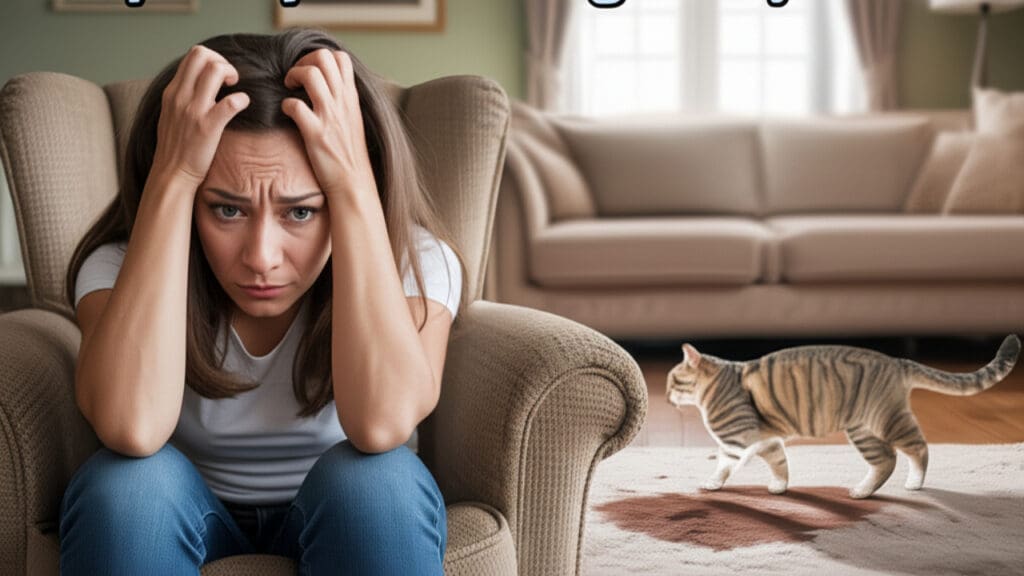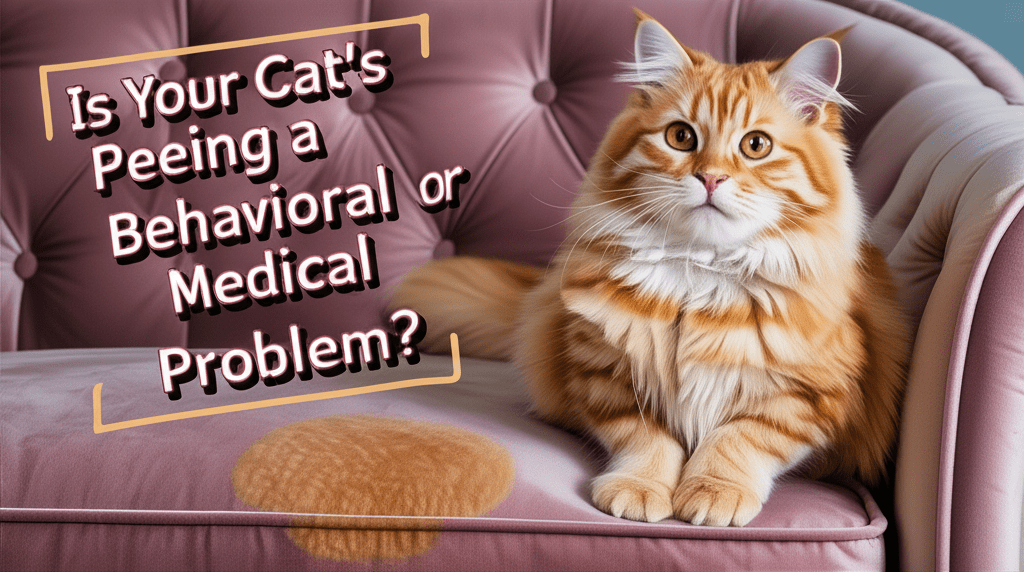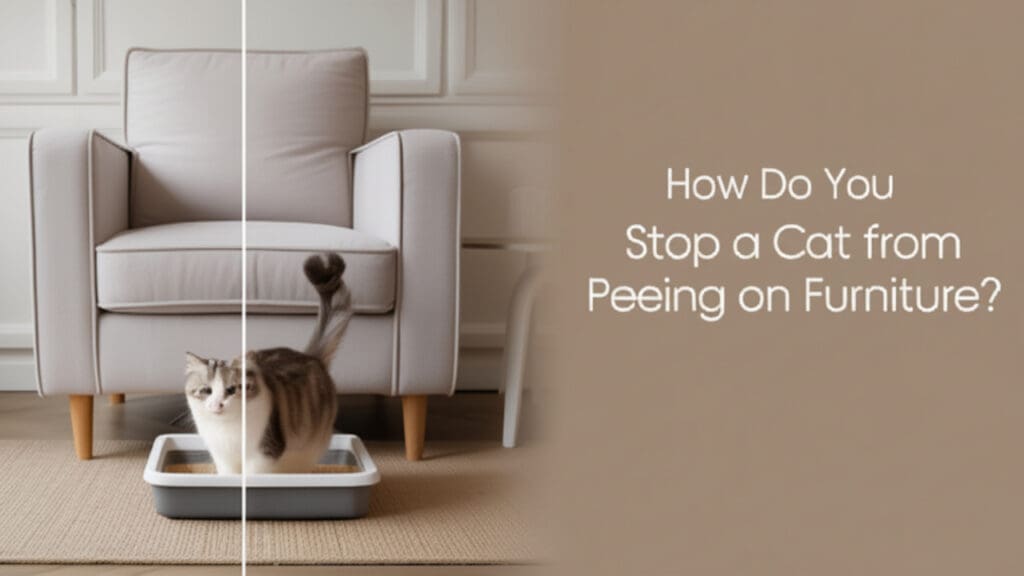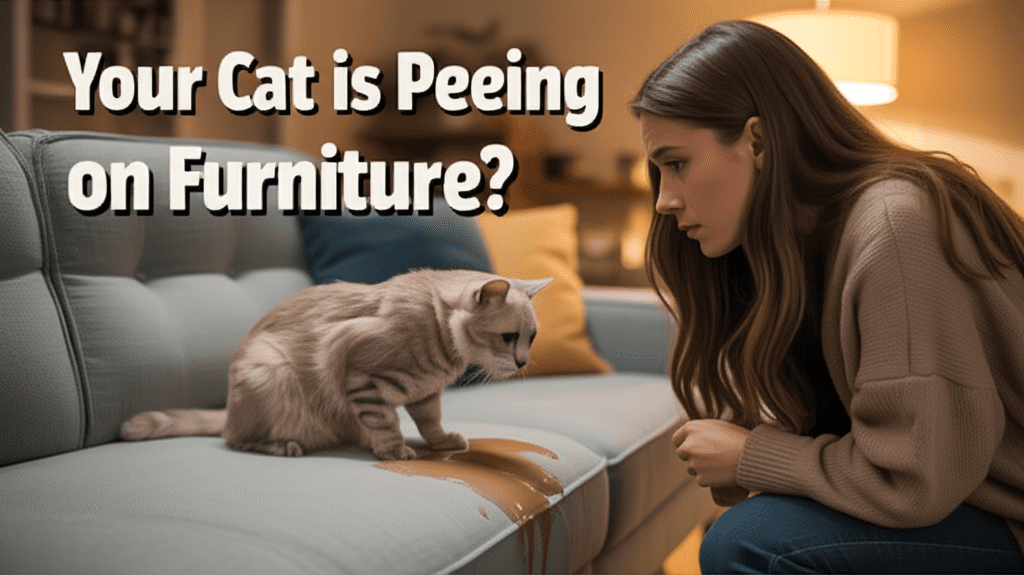Your Cat Is Peeing on Furniture?: Vet-Backed Causes, Cleaning Tips, Behavior Fixes & Prevention
It’s never a pleasant experience coming home, just to find that foul smell wafting in the air. What gives? Your cat is peeing on furniture again.
It’s an exhausting cycle, and it’s like your pet is protesting.
But that’s usually not the case. On the contrary, your little feline friend might actually be trying to tell you something; most likely, something’s wrong.
It could be that they are experiencing pain while peeing (from a condition called urinary tract infection), stress due to the environment, or even some negative association with the litter box.
That said, you can take proactive steps to correct this behavior.
You’ll soon learn how to pinpoint the reason behind your cat avoiding the litter box in this article. And we’ll also explore some vet-approved methods for eliminating that foul smell. Other solutions include increasing the number of litter boxes and using feline pheromone diffusers.
Also, avoid punishing your cat, as it’s most likely going to snowball into other bigger issues. And it might just hurt your relationship with your cat.
House soiling is a delicate issue we pet parents need to resolve. Be patient. Let’s dive into this together and find the best approach for you.
Why is My Cat Peeing on My Couch and Furniture?

So, your cat is peeing on furniture again. It’s messy, and the couch reeks of that familiar stench.
It’s hard for us to understand right away. But know that this is probably a sign. And this behavior might be due to health-related problems, stress, or discomfort.
One common reason cats pee on couches is because of territorial marking. Your cat will especially want to do this when they feel threatened. It could be by your new pet, a guest, or perhaps your new household scent. Unfamiliarity triggers this, basically.
Another thing is litter box aversion. Your cat might not like their litter box. Maybe it’s too dirty, too small, its surroundings are too noisy, or it’s an association with a painful peeing experience.
In some cases, the cause could be medical. Urinary tract infection (UTI), bladder inflammation (cystitis), and kidney disease are some examples. These conditions can make peeing urgent and painful.
Lastly, routine changes could cause the behavior, too. Our cats are usually comfortable with their usual daily routines. So disruptions to that, like sudden loud noises and new furniture, can stress them out. This could then lead to stress-induced urination.
Your Cat Is Peeing on Furniture: Behavioral vs. Medical Causes

It can be difficult to the untrained eye (sometimes even trained ones). But it’s important that we learn to tell the difference between behavioral triggers and medical conditions that lead to house soiling.
Both affect our cats’ urinary and litterbox issues. But they demand different approaches.
| Condition | Key Signs | Urine Characteristics |
| UTI | Straining, frequent trips | Cloudy, sometimes bloody |
| FIC | Howling, licking genitals | Usually normal |
| Kidney Disease | Increased thirst, weight loss | Dilute, pale |
From a behavioral perspective, the likelihood is that your cat is peeing on furniture to mark their territory. You may be familiar with this if you have lots of cats in your house. It is a natural instinct, and it helps them relieve stress. Sometimes, it could also be boredom that gets them to explore urinating in different spots.
On the other hand, your cat may be suffering from medical issues. These usually manifest as pain or physical discomfort. And they, in turn, make it hard for your cat to use the litter box. Common medical issues include urinary tract infections (UTIs), bladder inflammation (feline idiopathic cystitis), kidney disease, or urinary blockages.
If you’re not sure what causes the problem, always call for help. A vet can at least help you rule out health concerns before you start targeting the problem from a behavioral angle.
How to Deter Cats from Peeing on Furniture Using Vet-Recommended Methods?
There are definitely effective ways to stop cats from peeing on furniture. But remember that you’ll need to address the root cause before focusing on the environment. It’s a multi-step approach.
First, make sure you clean the soiled furniture using an enzymatic cleaner. If possible, find one that’s specifically meant for breaking down the uric acid in cat urine. Don’t use traditional cleaners. More often than not, they can’t remove the scent completely.
Next, you can cover the area with aluminum foil, plastic carpet runners (spiky side up), or double-sided tape. The idea is to make the area less appealing for future marking.
Also, set up multiple clean boxes in quiet, accessible places. Ideally, you should have at least one more litter box than the number of cats in the house. You should also consider the litter type. Unscented ones usually work best, but experiment with them.
Additionally, you could try using pheromone diffusers like Feliway®. They may reduce your cat’s stress and territorial anxiety. If you have more than one cat in your house, this may especially help.
Finally, you could include more enrichment activities. For example, try puzzle feeders, vertical spaces, and interactive play. These could help redirect your cats’ energy and reduce stress-induced behaviors.
Step-by-Step: How Do You Stop a Cat from Peeing on Furniture?

Correcting a cat’s behavior takes time and patience. You should take clear, practical steps to help you reach this goal. Punishment isn’t going to work out as well as you might think. Try this step-by-step structured approach instead:
Step 1: Rule out medical issues. Pay your vet a visit. Check for issues like urinary tract infections, bladder inflammation, or other underlying conditions.
Step 2: Deep-clean all soiled areas. Use enzymatic cleaners to get rid of scent markers. Invest in high-quality cleaners. You don’t want cleaners that might fail at doing their job.
Step 3: Evaluate and improve litter box conditions. Scoop every day, place the box in low-stress areas, and fill it with the litter your cat prefers. Try unscented clumping litter.
Step 4: Reduce stress and increase engagement. Watch out for environmental stressors (new pets, loud noises, or boredom). Offer vertical climbing space, regular playtime, and consistent routines to create a secure environment.
Step 5: Discourage furniture use as a bathroom. Block the affected area for some time. Consider using textures or scents that cats dislike to maximize the effect.
Step 6: Reinforce proper bathroom behavior. Praise your cat or reward them when they use the litter box. Positive reinforcement is always a good approach for nurturing good habits.
Your Cat Is Peeing on Furniture: What Neutralizes Cat Pee and Removes Odors Permanently?
Our cat’s urine has a strong smell, and the odor is persistent and difficult to remove. So, make sure you invest in the right enzymatic cleaner. It’s a product meant to break down the uric acid and proteins in cat urine.
Generally, enzymatic cleaners can digest the organic compounds of your cats’ urine and remove residual scent cues. This then prevents your cat from going back and peeing at the same spot.
If your furniture is made of fabric, try blotting up as much urine as possible with a dry cloth. Then, use enough enzymatic cleaner on the area. Saturate it for best result, and let it sit for some time. After that, blot the area again. Don’t try to steam clean or heat dry the area. It could stain the area or lock in the smell.
If your cat’s urine penetrates deep into the furniture, one attempt might not be enough. Repeat the steps as many times as necessary until the smell is gone. This can be a tedious process, but it’s also a necessary one.
Myths About Punishment to Keep Cats From Peeing on Furniture
Punishing your cats for peeing on the couch isn’t a good approach at all. It’s nothing but a common belief that could even make your feline friend’s behavior worse.
Your cat doesn’t make the connection between punishment and their past actions. If anything, it creates fear and anxiety. And might even be risking that trust.
Possibly the most damaging myth is that cats urinate on furniture to get revenge on us. It’s really not that. They are usually only doing so because of physical discomfort, emotional stress, or environmental disruption.
Is your cat peeing on your pillow? It’s unlikely that they’re mad at you. This is something called FIC (Feline Idiopathic Cystitis). When your cat is stressed, their body releases hormones that can actually make their bladder sore and inflamed. Cats with FIC exhibit an exaggerated sympathetic response and altered cortisol regulation, with studies showing significantly higher catecholamine levels and disrupted HPA-axis activity compared to healthy cats. The best way to help them is to use a calming pheromone diffuser. And if your vet says it’s okay, give your cat medicine like gabapentin. Yelling or punishing won’t help. It’ll likely make things worse.
Instead of punishing your cat, focus on understanding why they’re doing it. Create a supportive environment and encourage your cat to use the litter box.
It’d be best that you also use positive reinforcement to help correct the behavior. Reward them with treats, gentle praise, or even playtime. It’s a much better way to keep your bond stronger.
Remember, don’t react to the symptom. Address the cause, and be patient and compassionate about it.
Your Cat Is Peeing on Furniture: When to See a Veterinarian
At times, you’ve done everything right. The litter box is clean, and the environment is stable. It may even be ideal. But still, your cat is peeing on furniture.
In such cases, it’s probably time for you to see a vet. Medical issues are one of the most common causes for house soiling after all.
It’s painful for your cat if they suffer from conditions like urinary tract infections (UTIs), bladder stones, kidney disease, and feline lower urinary tract disease (FLUTD). They make urination uncontrollable and uncomfortable. And your cat may associate all the negative experiences with using the little box.
Pay attention to the warning signs. If you see your cats straining to urinate, peeing frequently but with little output, and there’s blood in the urine, seek help immediately. Other signs include your cat crying during urination or even licking their genital area excessively.
A vet, at the very least, can help you rule out medical conditions. So, tackle the problem early. It’s important for your cat’s health, and it ultimately helps prevent litter box avoidance.
Urgent Red Flags: When This Isn’t Just Pee
Look for these signs. Is your cat showing straining, but they’re not urinating? Are there visible blood clots in the urine? Are they howling while peeing?
If yes, call emergency care immediately. Note that urethral blockage can be fatal within 72 hours. A January 2025 study in the Journal of Feline Medicine and Surgery found that 27 percent of cats initially labeled with ‘behavioral’ house-soiling actually had undiagnosed partial or complete urethral blockages
Long-Term Prevention: How to Not Have Your Cat Urinating on Furniture Again
Correcting your cats’ behavior is one thing. But it’s another to prevent future accidents. To do so, you’ll need to create a safe environment for your little baby.
Start by keeping the little box area clean. Scoop every day and change the litter regularly. You should also wash the box with mild, unscented soap. If you have lots of cats, make sure that each one has their own litter box. And add an extra one just in case.
Be mindful of the placement, too. You should place the litter boxes in quiet, low-traffic areas. Your cat won’t appreciate doing their business near loud noises or busy walkways. Place a litter box near the area where your cat sprays inappropriately. It’s like a transitional cue.
Other than that, you’ll need to manage your cat’s stress level. Use environmental enrichment to your advantage. Climbing trees, puzzle feeders, and regular playtime help relieve stress. And they keep your feline friend stimulated.
You could also use pheromone diffusers or other calming sprays. If you’re making changes to your furniture arrangements, these tools might help.
Lastly, use cat-safe deterrents to cover areas that have been soiled before. And reinforce positive habits. Basically, discourage their negative behavior using deterrents, but encourage positive ones with treats, praise, or even playtime.
Choosing the Right Litter Can Make a Real Difference: Dr. Elsey’s Keeps Pet Parents and Cats Happy In Their Homes
It’s easy for people to say things like “try a new spot” or “clean more often.” But sometimes, the problem could actually be what’s in the box. No matter how perfect the litter box is, if your cat won’t step in, then all your efforts will have been fruitless.
And that’s when house soiling happens. It is one of the most common reasons cats out there lose their permanent homes.
Dr. Elsey’s is an innovative, cat-focused company that has made a mission of creating products that help keep cats happy, healthy, and in their loving homes for as long as possible.
Dr. Elsey’s was founded in 1987 by veterinarian Dr. Bruce Elsey and his wife, Kathy. They offer a selection of premium, science-backed litter to address issues like house soiling, while also supporting shelters nationwide and funding cancer research.
We like their Cat Attract® Litter and Stress Protection™ Litter because they’re compatible with most cats, and they’re great at controlling odors and keeping cats comfortable.
The Stress Protection™ Litter is a low-dust crystal litter with stress-reducing herbs, perfect for helping with anxiety-related urination. The Cat Attract® Litter uses a natural herbal scent to attract cats. It’s 99% dust-free, made with hard-clumping clay, and used for training cats with house soiling issues.
Frequently Asked Questions About Cat Peeing Behavior
1. Why did my cat just randomly pee on the couch?
This is most likely thanks to stress, health issues like a urinary tract infection, or environmental changes that mess up your cat’s routine and sense of safety.
2. How to punish a cat for peeing on a couch?
Punishment is no good. And it’s likely to stress your cat out more. Instead, use positive reinforcement and focus on finding out the reasons behind the behavior.
3. What to do if a cat peed on a sofa?
Quickly blot the area and apply an enzymatic cleaner. A good cleaner can help remove odors and help reduce the chance of your cat soiling in the same spot.
4. What neutralizes cat pee on furniture?
Enzymatic cleaners are the best option. They can break down uric acid crystals and get rid of the smell, not just masking it.
5. Will the smell of cat urine go away?
Yes, but only if you deal with it properly with a cleaner designed for cat urine. The smell can linger for weeks or even longer if you leave it alone.
6. What’s the difference between spraying and inappropriate urination in cats?
Spraying is a marking behavior. It usually involves small amounts of urine on vertical surfaces. Inappropriate urination is like going all out on horizontal areas like sofas or beds.
7. Can medical issues cause cats to urinate outside the litter box?
Absolutely. Urinary tract infections, bladder inflammation, or kidney problems can make urination urgent or painful. They are very common causes.
8. How does stress influence a cat’s peeing habits?
Stress makes your cat feel threatened or unsettled. And they may pee in inappropriate places as a signal. Triggers may include new people or pets, loud noises, or changes in routine.
9. Why is proper litter box placement important?
Cats need privacy and comfort, so quietness is rather important. They won’t want to do their business in a noisy or high-traffic area.
10. How do I keep my cat from peeing on the same spot again?
First, clean the area with an enzymatic cleaner. Then, block access temporarily, or place a litter box nearby. Lastly, reduce your cat’s stress level using appropriate methods and maintain a stable routine.
Restoring Peace and Cleanliness: What to Do When Your Cat Is Peeing on Furniture
It’s naturally a frustrating experience if your cat is peeing on furniture. But let’s seek to understand the why to find the best solution.
Seek out the root cause, whether it’s a medical condition, emotional stress, or territorial behavior. It helps you respond with clarity and care.
Keep in mind strategies like littler box management, using the right cleaners, and stress-reducing tools. You should now be able to handle this challenge head-on.
Be confident and trust your instinct. Stick to a consistent approach and remember that solving this problem is completely within your reach.
Has your cat ever peed on your couch or furniture before? What helped? Share your experience with us in the comments below!








